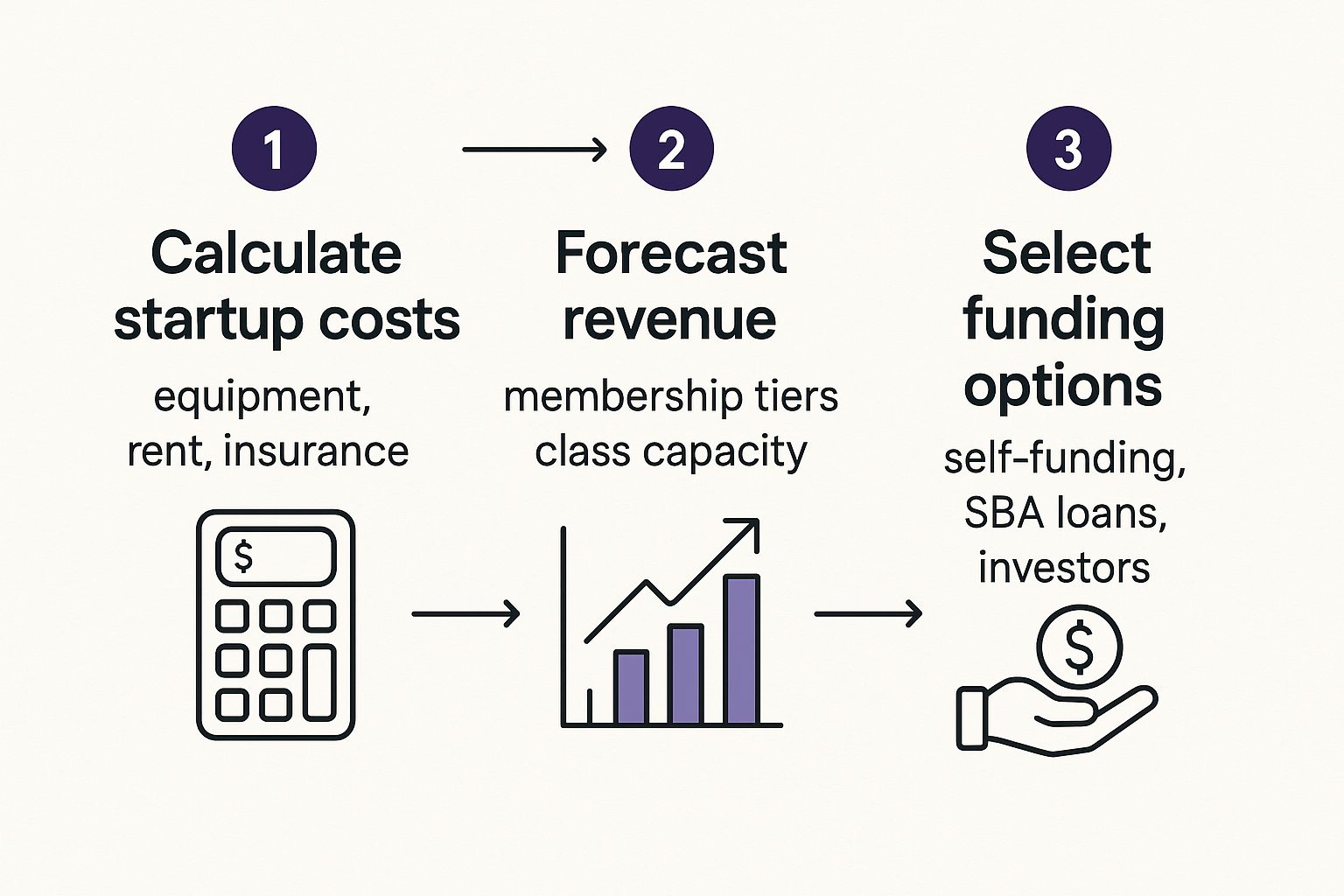

Ready to launch your dojo? Our guide breaks down how to write a martial arts business plan that secures funding, attracts students, and ensures success.
A solid martial arts business plan is way more than just a document you whip up to get a loan. Think of it as your strategic blueprint—the foundational kata that guides every single move you make as you build your school. Get this right, and every subsequent decision becomes more precise, powerful, and effective.

Before you even think about laying down the first mat or hanging the first heavy bag, you need a crystal-clear vision and a documented strategy to back it up. I’ve seen it a hundred times: passionate instructors jump straight into teaching, only to get completely swamped by the business side of running a dojo.
A well-structured plan is your defense against that chaos. It forces you to think through the nitty-gritty details of building a sustainable business, not just a fun passion project. This is the document that transforms your love for teaching into a profitable, thriving school that serves your community for years to come.
Your business plan will be built on a few key pillars, each tackling a different aspect of your school's operation. If you skimp on any one of these, you risk creating a weak foundation that can crumble under pressure.
Here’s what absolutely must be in your plan:
Working through these areas methodically creates a comprehensive guide for success. It’s the very first critical step in your journey. For an even deeper look at these initial stages, our guide on how to start a martial arts school offers some fantastic additional insights.
Key Takeaway: A business plan isn't just for getting funding. It's an internal tool that defines your mission, clarifies your strategy, and gives you a benchmark to measure your future success against.
To give you a clearer picture of the structure, the table below breaks down exactly what each section of your martial arts business plan needs to accomplish. Use it as a checklist to make sure you’ve covered all your bases.
This table is your at-a-glance summary of the essential sections. Each part is designed to answer specific, critical questions that potential investors, partners, or even you will have about your dojo's future.
Nailing each of these sections doesn't just make your plan look professional—it gives you the confidence that you've thought through every angle before you open your doors.

Your school won't exist in a bubble. Its success is completely tied to the community it serves and the other dojos already in the neighborhood. Think of your martial arts business plan as an intelligence-gathering mission—and this market analysis is the most critical part.
This isn't about guesswork. It's about getting real, hard data to prove your school has a fighting chance. You need to understand the actual demand in your area and, more importantly, find the specific gap that only your dojo can fill.
The good news? The industry is strong. The U.S. martial arts market is valued at around $19.4 billion and has been growing at a steady clip of 4.6% for the past five years. With roughly 18 million Americans training, the interest is definitely there. You can dig into these numbers and discover more insights about martial arts industry statistics. Your job is to carve out your piece of that pie, right in your own backyard.
Before you can find your students, you have to know exactly who you're looking for. It might sound a bit corporate, but creating an "ideal member profile" is a game-changer. It forces you to get laser-focused.
Who are you picturing on your mats?
Each of these groups has totally different needs, schedules, and budgets. The group you choose will shape everything—your class schedule, your marketing, even your prices.
Okay, you know who you want to teach. Now you need to find out if enough of them actually live in your target area. This is where you put on your detective hat and dig into local demographics.
Use free online tools like the U.S. Census Bureau or your local chamber of commerce website to pull up data on your chosen zip codes.
You're looking for a few key things:
This data tells you if there’s a real market for your vision. If you’re dreaming of a kids-focused karate program but the neighborhood is full of retirees, you’ve got a problem. It’s time to adjust your plan.
Pro Tip: Don't just rely on spreadsheets. Get in your car and drive around the neighborhoods you're considering. Go at different times of day. What kind of cars do you see? Who is out walking around? What other businesses are thriving? This gives you a feel for the community that numbers alone never will.
Knowing your competition isn’t about seeing them as the enemy; it's about spotting opportunities. You need to know what everyone else is doing so you can do it better—or do something completely different. This isn't an aggressive takedown, just a quiet, thorough assessment.
Fire up a simple spreadsheet to keep track of what you find. For every competitor in a reasonable driving radius, check out these key areas:
This analysis is a cornerstone of your martial arts business plan. It's the proof you need to back up your unique value proposition—that one clear, compelling reason a student should walk through your doors instead of anyone else's.
Passion for your art is the fuel, but a solid operational plan is the engine that makes your dojo run. This is the part of your martial arts business plan where the rubber meets the road—detailing the day-to-day mechanics of your school. It’s how you turn your vision into a real, breathing business.
Here, we'll get into the nitty-gritty decisions. We’re talking about everything from picking the perfect spot and wrestling with a commercial lease to crafting a class schedule that keeps your mats full. A well-oiled operations plan ensures your school runs as smoothly as a perfectly executed kata.
Your dojo's location is easily one of the biggest calls you'll make. It’s a decision that directly impacts how many people see you, how easily they can get to you, and how much you'll pay in rent each month. You need a space that not only fits the budget but also feels like the right home for the community you want to build.
Keep these factors front and center:
Your class schedule is the heartbeat of your dojo. Get it wrong, and you'll have empty classes and wasted mat time. But a smart, strategic schedule keeps students coming back and your facility buzzing with energy.
Start by mapping out a schedule that speaks directly to your ideal student. If you’re targeting kids, those after-school and weekend morning slots are gold. For working adults, you'll want to offer classes early in the morning, during lunch, and in the evening.
Aim for a balanced mix of classes:
A classic mistake is trying to be everything to everyone right out of the gate. Start with a core schedule that serves your main demographic. As your membership grows, listen to what your students are asking for and expand from there.
Let's be real: you can't do it all yourself. Assembling the right team is absolutely essential for delivering a top-notch experience and, frankly, for preventing your own burnout. Your staffing needs will change over time, but your business plan needs to show you've thought about who you'll hire first.
Define the key roles and what they'll be responsible for. Even if you're the only instructor at the beginning, you'll probably need someone at the front desk to answer calls, sign people up, and handle payments. As you expand, you’ll need more qualified instructors to keep a healthy student-to-teacher ratio.
When you hire, look for a mix of technical skill and personality. A phenomenal martial artist who can’t connect with a seven-year-old is not going to work in a family-focused dojo. Having clearly defined roles is a game-changer, and you can get some great insights by exploring how to approach mastering the training for your martial arts school staff, which helps ensure everyone is on the same page from day one.
Not too long ago, school owners were drowning in paperwork. Today, good dojo management software is non-negotiable if you want to run an efficient school. This is the technology that handles all the administrative grunt work so you can stay focused on teaching.
Your business plan should name the software you intend to use. You'll want a platform that brings all these key functions together:
Picking the right software from the get-go streamlines your entire back-office operation. This isn’t just about convenience; it’s a fundamental part of building a professional and scalable business. It frees up your most valuable asset—your time—so you can pour it back into your students.

An empty dojo is just a room with mats. All the financial projections and brilliant operational plans in the world don't mean a thing if you don't have a steady stream of students walking through the door.
This section of your martial arts business plan is where we get down to brass tacks. It's about how you're going to fill those mats, sign up new members, and build a community that people are excited to be a part of.
Forget the generic marketing fluff. We're talking about real, actionable tactics that work for martial arts schools. This is about building a brand that reflects your school's unique philosophy and connecting with the exact people looking for the discipline, confidence, and community you provide.
Your brand isn’t just a cool logo or a catchy name. It’s the feeling people get when they think about your school. It's the promise you make to every single student and parent who walks in. A solid brand identity instantly tells people what makes your dojo different from the one down the street.
Are you a family-focused karate school that puts a premium on respect and discipline? Or maybe you're a high-intensity Brazilian Jiu-Jitsu gym that caters to competitors. Whatever your focus, your messaging, your visuals, and even the way you answer the phone need to be in perfect alignment.
Putting all your eggs in one marketing basket is a recipe for painfully slow growth. A smart plan uses a mix of digital and good old-fashioned offline tactics to reach potential students wherever they might be. This ensures you're building awareness while also capturing people who are actively searching for classes right now.
Digital Marketing Essentials:
Offline and Community-Based Tactics:
The industry is healthy, with over 50,000 martial arts studios across the United States. These schools are thriving by offering a variety of classes and using smart management and marketing. A solid marketing plan is your key to getting a piece of that action.
Your marketing plan shouldn't be set in stone. It’s a living document. Track what's working—did that Facebook ad bring in trials? Did the local fair generate good leads? —and double down on whatever gives you the best results.
The journey from a curious phone call to a committed member needs to feel smooth and welcoming, not like a high-pressure sales pitch. Your "sales" process should feel more like a personal invitation to join your community.
Start with a great introductory offer. A free trial week or a discounted first month with a free uniform are classics for a reason—they remove the risk and let people experience your classes firsthand.
Once they're in the door, it’s all about building rapport and making sure they have an amazing experience. An engaging trial class is your single most powerful sales tool. We’ve got some great ideas for this in our guide on how to improve student engagement in your dojo. Your goal is simple: make them feel like they belong before they've even signed up.
Alright, this is where the rubber meets the road. Your vision for a packed dojo, buzzing with energy, needs to translate into dollars and cents. The financial section of your martial arts business plan is, without a doubt, the part that potential lenders or investors will pick apart the most. It's the ultimate proof that your passion project has what it takes to be a profitable, long-term business.
Don't get spooked by the spreadsheets. Think of financial forecasting as making educated guesses based on the solid research you've already done. You're simply laying out your startup costs, projecting your income, and drawing a clear map to profitability. This isn't just for a loan application—it's your personal guide to financial health.
Before you make a single dollar, you've got to spend some. Nailing down your startup costs is the first critical step. Underestimating this number is one of the quickest ways for a new school to fail, so be meticulous. It even pays to be a little pessimistic here.
Your costs will break down into two main buckets: the things you buy once and the bills that come every month.
One-Time Startup Costs:
Initial Recurring Costs (Budget for 3-6 months):
This infographic breaks down the simple, three-stage process for getting your financial foundation right.

This process—calculating costs, forecasting revenue, and then figuring out funding—is the logical core of your entire financial strategy.
Once you know what you'll be spending, it's time to project what you'll be earning. This can feel like pure guesswork, but you can ground it in reality. Base your forecast on your class capacity and the pricing structure you've decided on. Memberships will be your bread and butter, but don't forget about other ways to bring in cash.
A tiered membership model works well for most schools:
Let’s run a quick, back-of-the-napkin calculation. Say your mat space can safely hold 20 students, and you're offering 15 classes a week. That's a total capacity of 300 student spots each week. If you conservatively guess you'll fill just 50% of that capacity in your first year and your average student is worth $150/month, you can start to build a revenue model that feels real. With the martial arts market projected to hit $171.14 billion globally by 2028, a clear plan helps you grab your slice of the pie.
Key Takeaway: Be conservative with your first-year financial projections. It’s always better to present a realistic plan you end up crushing than an overly optimistic one you miss by a mile. Lenders and investors appreciate realism.
Now for the million-dollar question (or maybe the $50,000 question): where is the money going to come from? With your costs itemized and your revenue projected, you know exactly how much cash you need to get the doors open and keep them open until you're in the black.
You've got a few common paths to funding a new dojo:
To give yourself the best shot at securing capital, it pays to understand exactly how to get a small business loan, from prepping your financials to finding the right lender. When you have your numbers dialed in and your plan polished, you'll walk into any meeting with the confidence to make a compelling case.
Jumping into dojo ownership brings up a lot of questions. Even with a killer business plan, you're bound to have some nagging practical concerns pop up. I get it.
Let's tackle some of the most frequent—and critical—queries I hear from aspiring school owners. My goal is to give you direct, no-fluff answers to help you sharpen your martial arts business plan and get moving.
This is the big one, and the honest answer is: it depends. Startup costs can swing wildly, but a realistic range is anywhere from $10,000 for a lean, scrappy launch to over $100,000 for a premium facility in a high-rent area.
The final number really boils down to a few key variables. Your location is always the biggest piece of the puzzle; commercial rent will almost certainly be your largest monthly bill.
Beyond the lease, think about the size of your space and the quality of gear you need. High-grade mats, heavy bags, and pads are a serious one-time investment, but you don't want to cheap out here. You'll also need to budget for your initial marketing push, insurance premiums, and any local licensing fees.
Your financial plan needs a line-item budget that includes:
Don't skip that last one. That cash reserve is your safety net, and it’s what will let you sleep at night while you're building up your student base.
When you're starting out, it's easy to get lost in a sea of data. My advice? Keep it simple and focus on the handful of key performance indicators (KPIs) that actually tell you if your school is healthy or not.
These are the numbers that truly matter:
The Golden Rule: A healthy, sustainable business model is one where your Student Lifetime Value (LTV) is significantly higher than your Student Acquisition Cost (SAC). If it costs you $100 to get a new student, they better be worth a lot more than that over time.
Tracking these few numbers lets you make smart, data-driven decisions about where to put your marketing dollars and how to improve the experience for your students.
If I had to pick just one, it's this: underestimating your expenses while overestimating your revenue. It’s a classic trap born from passion and optimism, and I've seen it sink more schools than I can count.
So many amazing instructors believe that because they are phenomenal at their art, students will just magically appear the moment the doors open. It rarely, if ever, works that way.
Your business plan must be anchored in conservative, well-researched numbers. Don't just budget for the obvious stuff like rent and equipment. You absolutely have to account for the "hidden" expenses that nibble away at your profits—things like credit card processing fees, ongoing facility maintenance, annual hikes in your insurance, and the constant need for marketing spend.
A truly solid plan includes a break-even analysis. This calculation shows you precisely how many active, paying students you need each month just to cover all your costs. This number isn't just an abstract figure on a spreadsheet; it becomes your first clear, tangible goal and the most realistic benchmark for success.
Trying to manage student billing, track attendance, and handle new sign-ups can quickly pull you away from what you love—teaching. Martialytics is built to automate those headaches, giving you back hours every single week. From digital onboarding to effortless payment processing, our software helps you run your school like a pro from day one. See how over 1,295 schools are growing their business by starting a free 30-day trial.


No credit card required. No lock in contracts. Start your 30-day free trial to see immediate improvements.

Book your free demo with one of the co-founders of Martialytics, Brad or Allen, depending on your time-zone.
We'll do this on Zoom video conferencing software for awesome screen sharing so please make sure you have the app or are good to go before the time starts.